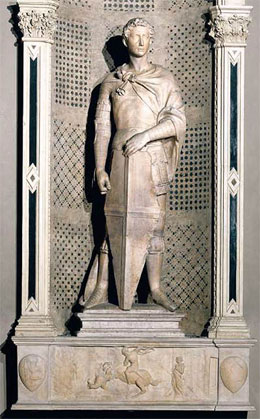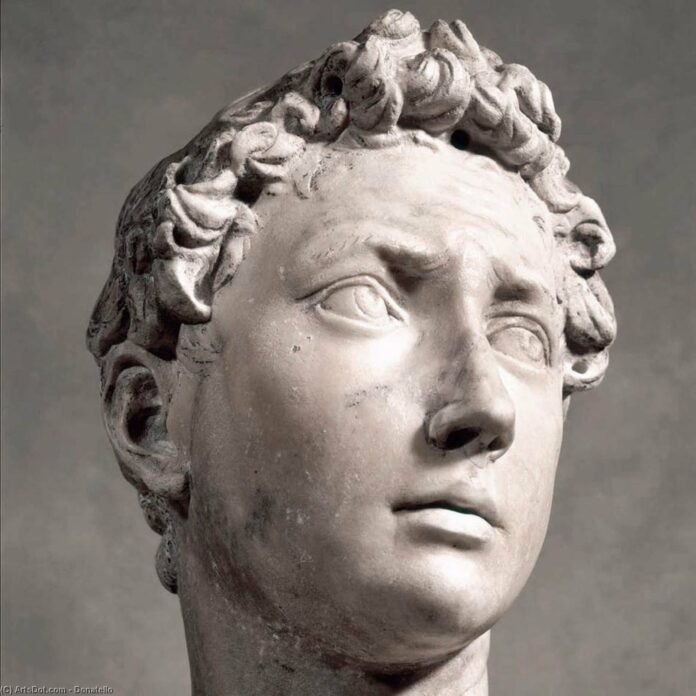Donatello would become known as the most important sculptor to resuscitate classical sculpture from its tomb in antiquity, through an invigorated style that departed from the Gothic period’s flat iconography. He broke ground by introducing new aesthetics in line with the time’s flourishing move toward Renaissance Humanism – a movement that emphasized a departure from medieval scholasticism and favored deep immersion into the humanities, resulting in art that no longer focused solely on the secular realm of religion but explored man’s place in the natural world. Donatello’s signature lifelike and highly emotional works would place him as one of the most influential artists in 15th century Italy, and an early forefather to the Italian Renaissance.
 Donatello – St. George
Donatello – St. George
Museo Nationale del Bargello, Florence
Donatello was commissioned by the swordmakers’ and armorers’ guild to carve this sculpture of their patron saint, St. George, for a niche on the exterior of the church of Orsanmichele in Florence. The work is a life-sized depiction of the saint standing atop a marble panel which is carved to illustrate the famous mythical moment when George slayed the dragon. Although the work was meant to reflect the Florentine spirit of holding strong against all adversaries, Donatello’s meticulous rendering of the emotionality of the face also betrays a distinct vulnerability and softness. This expertise in portraying emotion, as is also seen in his equestrian statue of condottiero Erasmo da Narni, was a signature technique of the artist toward humanizing subjects that would traditionally be presented in a more idealized fashion.
The work marks an important moment in the development of sculpture because Donatello brought back the ideals of classical sculpture and married them with a new realism, departing boldly from the prior Gothic mannerism. The marble panel at the base is also an important work of art in its own right. It is a key early example of a bas-relief made using the principles of linear perspective, which was infiltrating painting at the time. The shift from empirical perspective to linear perspective is one of the key discoveries that contributed to the development of Renaissance art. Donatello would have been familiar with the experiments with perspective drawn by his friend Brunelleschi, and his skill was to apply them to the challenging medium of bas-relief carving.
Vasari’s was very appreciative of this work, and his fine criticism captured the essence of Donatello’s work more than any other volumes praising the sculpture. He noted that the statue of St. George in his armour, with its “vivacity terrible and audacious” reflects the beauty of youth, and the moral values of courage and chivalry. The marvelous gesture and the life-like appearance are giving the impression that “the spirit stirred within the stone.”
And this is exactly what is so specific to many of Donatello’s sculptures: his unique skill of capturing a transitory expression in such a manner that the figure seems alive.
The statue is probably the most popular of Donatello’s works. It has a youthful beauty, a boyish modesty, and great delicacy. It conveys the values of chivalry, in a time when many young citizens of Florence were behaving like the chivalric ideals never existed.
Marble – National Museum of Bargello, Florence
Source: https://www.theartstory.org




